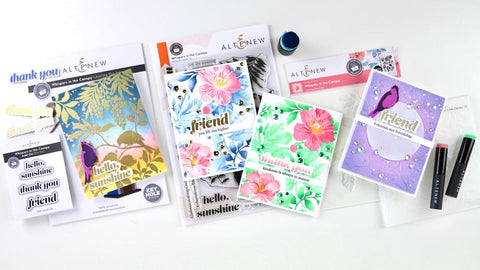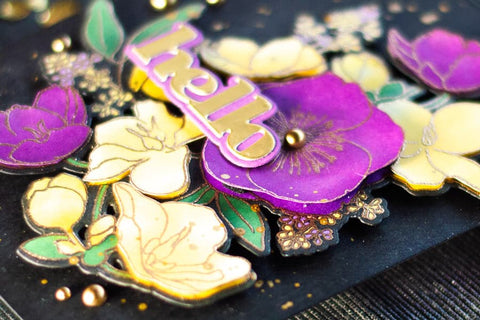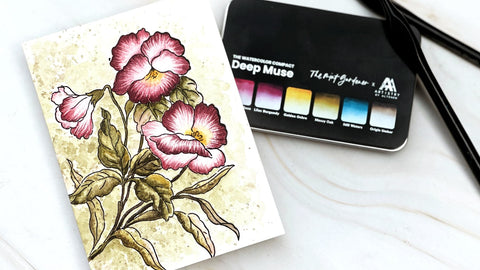What Are Liquid Watercolor Paints?
Last Updated: October 28, 2025
There are tube and watercolor pan sets, and then there are liquid watercolors or bottled watercolors. Liquid watercolor paints are both concentrated dye and pigment solutions that can be used just like other watercolor paints. They come in a wide range of colors and can also be used as refills for brush pen markers. There are many different ways to use liquid watercolor and we’re sharing a few to get your creative juices flowing!

Fun Fact: One of the ingredients of the traditional old watercolor recipes is honey! It is the honey that makes the watercolors soft and allows them to stay in a semi-liquid form for long enough.
What’s the Fuss About Liquid Watercolor Paints?
Watercolor paints are fun to use as coloring mediums. They are great for achieving washed-out and smokey effects, especially in paper crafting. Liquid watercolor paints offer a lot of conveniences too. They are already in liquid form and don’t need to be activated like pans or tubes. Liquid watercolors are just as pigmented and vibrant as traditional watercolor paints too!
They typically come in glass or plastic bottles with either pipettes or nozzles as a way to transfer them onto a mixing palette. From there, they can be treated as regular activated watercolors by using a brush to apply them to your paper or cardstock. This is why artists and crafters alike love liquid watercolors for their ease of use.

Tropical Fiesta Liquid Watercolor - Brush Marker Refill Bundle
Is Liquid Watercolor Good?
Liquid watercolors are known to produce super transparent colors but are nonetheless vibrant. When used straight out of their bottles, they can immediately be painted on paper or even fabric. They can be used for painting and washes just like sets and pans, and are also suitable for calligraphy. Some solutions can also be used in fountain pens and airbrushes other than brush markers!
How to Use Liquid Watercolor?
Mixing colors with liquid watercolors is just the same as traditional ones. Pour colors separately onto your trays or mats and mix these with a watercolor brush to achieve your desired color. Add more water to make them lighter, and add more of the paint to make them more vibrant. Liquid watercolors are no doubt great coloring mediums.

Spring Garden Liquid Watercolor - Brush Marker Refill Bundle
Is Liquid Watercolor the Same as Watercolor Ink?
As mentioned, liquid watercolors are based on dyes plus pigments yet are used exactly like regular watercolors. They are already fluid and can be used straight for painting. So there’s no need to dilute them unlike you would if you wanted to paint using solid, dry cakes.
Tips on How to Paint with Liquid Watercolors
- If you want a more vibrant color, use less water.
- If you want a lighter color, dilute them with more water.
- Because they don’t dry like tubed watercolors, it’s best to put them in small, clear glass containers or a watercolor palette. And then, from there, gather the pigments with your brush to mix on your palette. This way none of the product is wasted especially if the leftover can’t be returned back into their bottles.
They are great for covering large areas fast by using a medium or large flat brush.

Ultimate Liquid Watercolor - Brush Marker Refill Bundle
3 Things You Can Do with Liquid Watercolor Paints
1. Create mystical cards with professional-looking results.
Here is a blog post that will help you practice and get a feel of mixing water with liquid watercolor paints. You’ll learn how to create a super colorful image using only a few colors like what Norine did. She also demonstrates how to paint with shades and shadows using only one color.

Paint-A-Flower: Coral Sunset Outline Stamp Set
These cards are just a few examples of what you can create with liquid watercolor. You can either use brush marker pens or regular paint brushes to achieve these effects!
2. Blend with other coloring mediums and mixed media.
Use them to color embossing paste! Our designer, Lydia, shares an amazing way to use liquid watercolor paints in crafting. Below is a card created with colored embossing paste using watercolor brush refills or liquid watercolor!

As you can see, the color results are dreamy! It’s super vibrant and has achieved an opaque look when mixed with the embossing paste. Find out how to recreate the card here.
3. Create different textures with liquid watercolor!
Our designer, Svitlana, created a soap bubble effect using liquid watercolor mixed with water and dishwashing soap! Mix these three in a container and use a straw to blow into the mixture to create colorful bubbles.

Autumn Blaze Liquid Watercolor - Brush Marker Refill
Take a blank watercolor panel and “pick up” these bubbles. Once these bubbles pop on the panel, they’ll leave these interesting bubble marks! Find out more in detail about how she did it here.
Explore Liquid Watercolor Paints
Liquid watercolors paints can be used in so many ways for paper crafting and card making. They are good painting mediums, and they are even greater crafting mediums! They act like both watercolor and inks hence they work so wonderfully with all the supplies used in crafting like embossing paste, stamps, stencils, and dies! You won’t run out of combinations for your projects.
If you’re looking for more crafting ideas, tips, and inspiration, feel free to check out our All About Crafting page.
















I need to create a test platform to understand colors to make neutral density camera filters, End up with a grey color that is neutral to the transmission of light